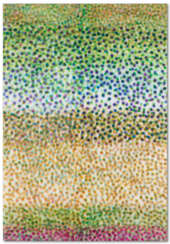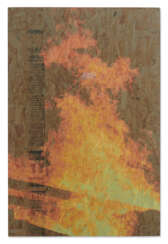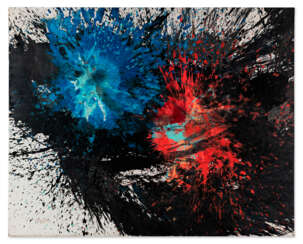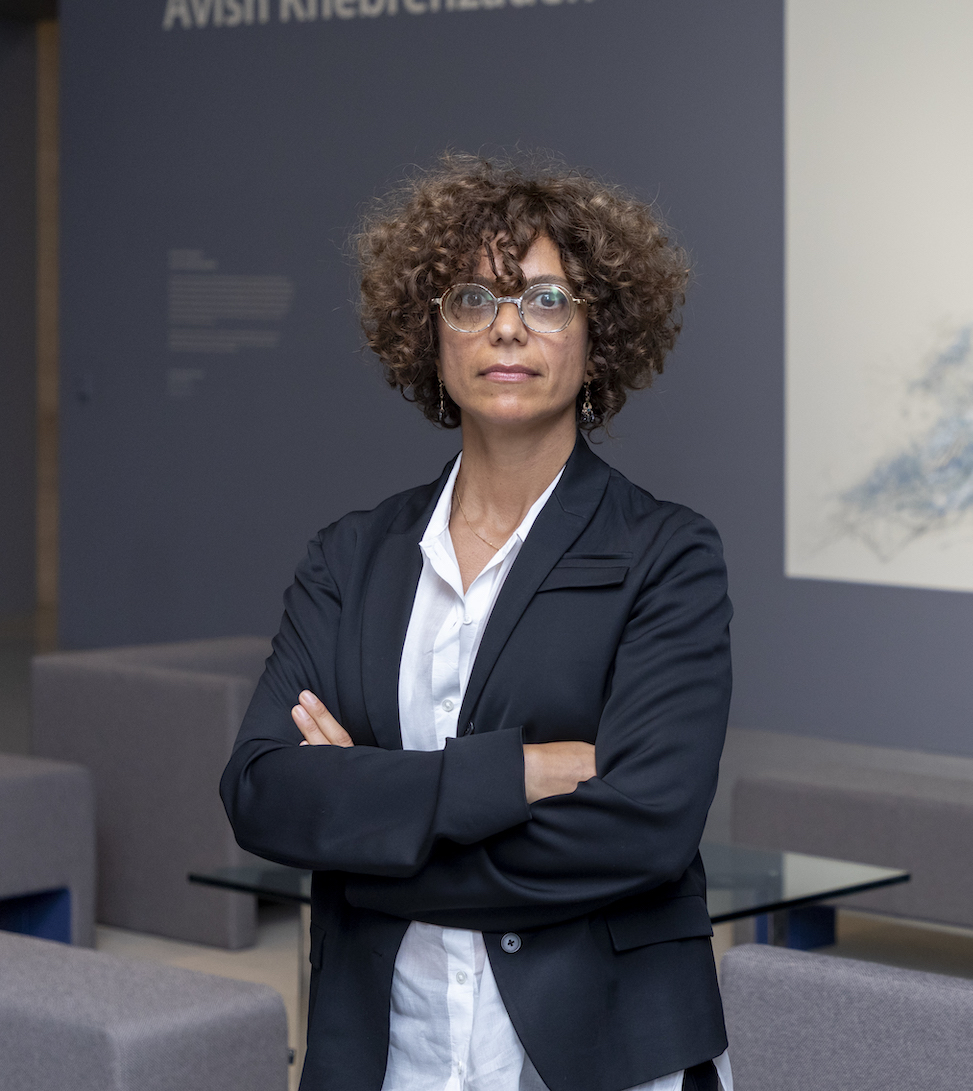
Paintings — No Regrets: The Collectors' Edition

Parker Ito is an American contemporary artist. He was raised in Long Beach, California and currently works in Los Angeles. Ito's art practice encompasses a wide range of media, including painting, sculpture, video, performance, and installation.
Ito is known for his exploration of the intersection of technology and contemporary art. He often incorporates digital elements into his work, such as using UV printing on canvas, digital painting, and 3D printing. Ito's work also frequently deals with issues of identity, representation, and the commodification of art.
Ito has exhibited his work in numerous solo and group exhibitions in galleries and museums around the world.

Ryan Mendoza is an American contemporary artist. He is best known for his large-scale installations and sculptures that explore themes of memory, identity and social justice. He works and lives between Naples and Berlin.
Mendoza often works with found objects and materials, reworking them to create new meanings and contexts. He has created installations using discarded and forgotten objects such as abandoned houses and furniture to create powerful commentaries on the human condition.
One of Mendoza's most famous works is White House, which he created in 2016. The installation was a replica of the house Rosa Parks lived in after her famous act of civil disobedience in Montgomery, Alabama. Mendoza moved the entire house from Detroit to Berlin and opened it as a public exhibition. The work was a powerful commentary on the ongoing struggle for civil rights in the US and around the world.
Mendoza's work has been exhibited in numerous solo and group shows around the world, including the Venice Biennale, the Smithsonian American Art Museum and the Studio Museum in Harlem. He has received several awards and grants for his work, including a grant from the Joan Mitchell Foundation in 2004 and a grant from the Pollock-Krasner Foundation in 2011.

Sebastian Black is a contemporary American artist from New York whose work is stylistically reminiscent of Cubism. The artist is best known for his Puppy Paintings series, in which he depicts puppy muzzles in fragmented abstract shapes and warm tones.

Piotr Makowski is a contemporary artist from Poland. He works primarily in painting and drawing, and his work often explores themes of memory, identity, and the passage of time.
Makowski studied at the Academy of Fine Arts in Gdańsk, Poland, and has since exhibited his work in numerous solo and group exhibitions in Poland and abroad. In 2013, he was awarded the Paszport Polityki award, one of the most prestigious awards for artists in Poland.
Overall, Makowski's work is marked by a keen sensitivity to the world around him, and an ability to capture the essence of his subjects with a subtle, understated touch.

Peter Sutherland is an American artist and photographer, known for his experimental approach to photography and his use of a wide range of materials and techniques. He is based in New York City.
Sutherland's work often explores themes of nature, urbanism, and the built environment. He is particularly interested in the intersection between human-made structures and natural landscapes, and his photographs often feature scenes of decay, erosion, and transformation. He is also known for his use of collage and mixed media, incorporating found materials such as old books, magazines, and maps into his work.
Sutherland has exhibited his work in galleries and museums around the world, and has published several books of his photography. He is also a co-founder of the art and culture publication Paper Work NYC.
Overall, Sutherland's work is marked by a sense of curiosity and experimentation, as well as a deep appreciation for the beauty and complexity of the natural world. His photographs and collages invite viewers to reconsider their relationship to the built environment and the natural world, and to see beauty in unexpected places.

Yves Corbassière is a French painter, printmaker, poster designer, set designer, sculptor and lithographer, close to American Action Painting.
Yves Corbassière is the author of over 5,000 works. Widely known in the United States, his work is exhibited in some forty American museums.
In addition to painting, Corbière was also an accomplished printmaker, working in a variety of techniques including etching, lithography, and silkscreen. His etchings often had the same bold, abstract shapes and vivid colours as his paintings.
Overall, Corbassiere's work is characterised by energy and dynamism, as well as a deep understanding of the expressive potential of colour and form.

Larry Bell is an American contemporary artist and sculptor. He is best known for his glass boxes and large-scaled illusionistic sculptures. He is a grant recipient from, among others, the National Endowment for the Arts and the Guggenheim Foundation, and his artworks are found in the collections of many major cultural institutions.

David Noonan is an Australian artist. He is known for his work in sculpture, installation and painting.
Noonan often uses found images and materials in his work, which he combines with his own photographs, drawings and other materials to create collages, assemblages and installations. He is particularly interested in how images can be transformed and re-contextualised through different mediums and forms.
Noonan has exhibited his work in many major art institutions and galleries around the world. In 2016, he was awarded an Australian Visual Arts Council Award.
His notable works include a series of large-scale silkscreened linen panels displaying monochrome photographic representations of artists, landscapes and still lifes; sculptures and installations, often referencing theatre and film.

Derek Paul Boyle is a contemporary American visual artist whose work often deals with the anthropomorphism of everyday objects and absurdist interventions.
Boyle received his BFA from Emerson College in Boston and his MFA in Digital and Media Studies from Rhode Island School of Design.
Boyle has exhibited his work nationally and internationally, including exhibitions at the Museum of Modern Art in Cleveland, the Museum of Fine Arts in Boston and the Saatchi Gallery in London. His work is included in the collections of the Whitney Museum of American Art, the Museum of Fine Arts Boston, the Cleveland Museum of Art and others.
In addition to his studio practice, Boyle also teaches art and works as a visiting artist at various institutions, including the Rhode Island School of Design, the School of Visual Arts and the University of Michigan.

Marieta Cirulescu is a Romanian-German artist known for her abstract and conceptual paintings. She studied at the Academy of Fine Arts in Bucharest and at the Academy of Fine Arts in Nuremberg, Germany.
Cirulescu's work is characterised by calm colours and minimal compositions, often featuring repeating patterns and forms reminiscent of organic forms and structures found in nature. She is interested in the interplay of the organic and geometric, and her works often evoke a sense of movement and growth.
Cirulescu has exhibited her work extensively in Europe and the United States, including exhibitions at the Museum of Modern Art in Frankfurt, the Kunstmuseum Bonn and the New Museum in New York. She was also included in the Romanian pavilion at the 2013 Venice Biennale.
Cirulescu is the recipient of numerous awards and grants, including the Villa Romana Prize in 2004 and the Berlin Senate Fellowship in 2009. She currently lives and works in Berlin.

R. H. (Rebecca Howe) Quaytman is an American contemporary artist, best known for paintings on wood panels, using abstract and photographic elements in site-specific "Chapters", now numbering 35. Each chapter is guided by architectural, historical and social characteristics of the original site. Since 2008, her work has been collected by a number of modern art museums. She is also an educator and author based in Connecticut.

Norbu Tsering, who goes by the artistic name Nortse, is a Tibetan artist. He is known for his contemporary paintings, which often incorporate traditional Tibetan iconography and Buddhist themes.
Nortse studied art at various institutions, including Tibetan University in Lhasa, the Central Academy of Art in Beijing and art academies in Guangzhou and Tianjin. He then worked as a professor of art at Tibetan University in Lhasa. He has exhibited his work in solo and group shows in China, Tibet and abroad, including at the Museum of Contemporary Art in Taipei and the Asian Art Museum in San Francisco.
Nortse often draws himself into his compositions, such that his practice reads as a culminating anthology of pictorial documents that sheds light on his identity and reality. His previous training in stage design proved pivotal in his current artistic practice as he moves freely across media. Photography is combined with painting, laden with tactile materials often harvested from daily life, in order to build images that raise questions on troubling global phenomena and, at the same time, proffer hope for our collective future.
Nortse's paintings often feature bold, vivid colors and intricate patterns, and he frequently uses gold leaf and other traditional materials in his work. He draws on his Tibetan heritage and Buddhist upbringing to explore themes of spirituality, identity, and cultural heritage. His work has been praised for its ability to bridge the gap between traditional Tibetan art and contemporary art, and for its powerful message of cultural resilience and pride.

Norbu Tsering, who goes by the artistic name Nortse, is a Tibetan artist. He is known for his contemporary paintings, which often incorporate traditional Tibetan iconography and Buddhist themes.
Nortse studied art at various institutions, including Tibetan University in Lhasa, the Central Academy of Art in Beijing and art academies in Guangzhou and Tianjin. He then worked as a professor of art at Tibetan University in Lhasa. He has exhibited his work in solo and group shows in China, Tibet and abroad, including at the Museum of Contemporary Art in Taipei and the Asian Art Museum in San Francisco.
Nortse often draws himself into his compositions, such that his practice reads as a culminating anthology of pictorial documents that sheds light on his identity and reality. His previous training in stage design proved pivotal in his current artistic practice as he moves freely across media. Photography is combined with painting, laden with tactile materials often harvested from daily life, in order to build images that raise questions on troubling global phenomena and, at the same time, proffer hope for our collective future.
Nortse's paintings often feature bold, vivid colors and intricate patterns, and he frequently uses gold leaf and other traditional materials in his work. He draws on his Tibetan heritage and Buddhist upbringing to explore themes of spirituality, identity, and cultural heritage. His work has been praised for its ability to bridge the gap between traditional Tibetan art and contemporary art, and for its powerful message of cultural resilience and pride.
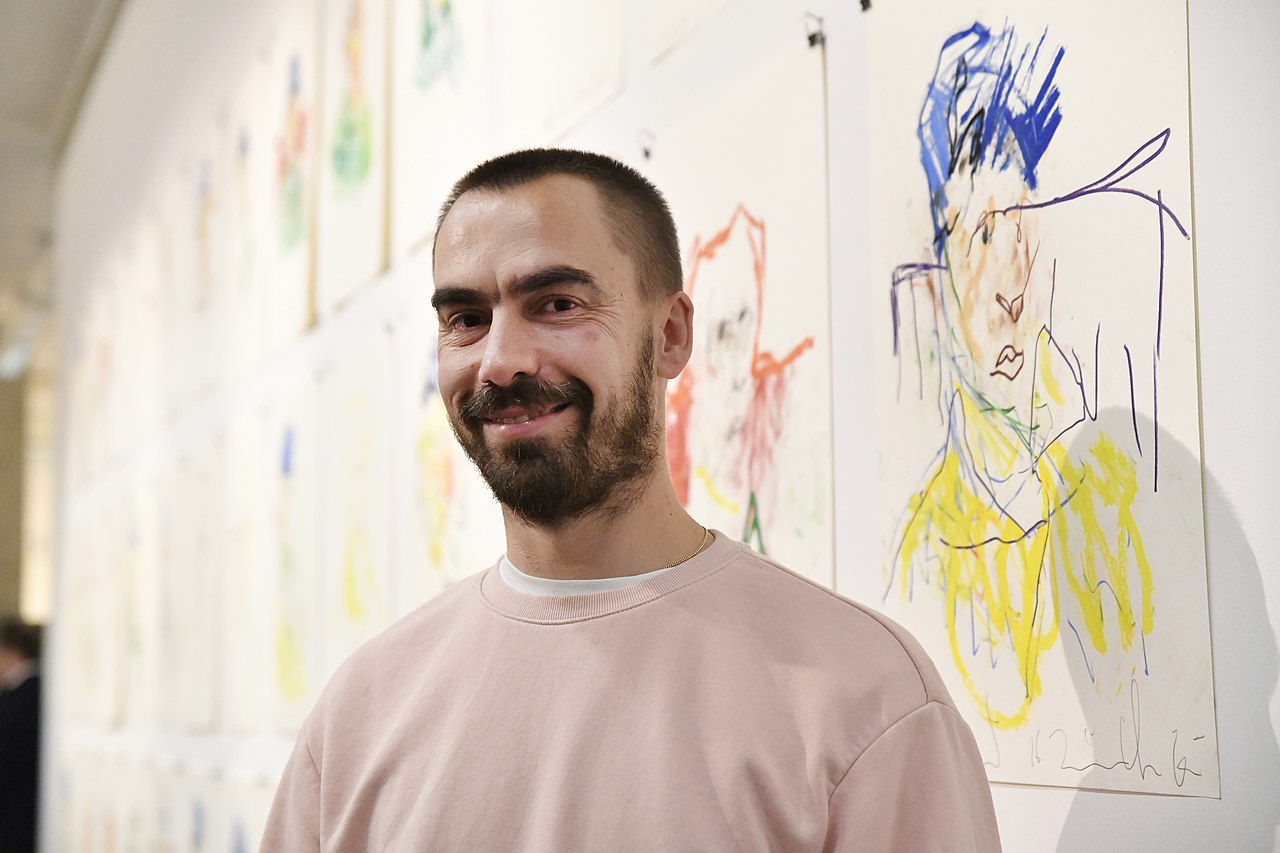
Guillaume Bruère is a French painter, drawer, sculptor and performer. He lives and works in Berlin.
Guillaume Bruère graduated from the Ecole des Beaux-Arts de Nantes (DNSEP) in 1999, then from the Ecole Européenne Supérieure de l'Image in Poitiers in 2003.
Fascinated by the major artists of art history (Holbein, Dürer, Rembrandt, Goya, Van Gogh, Giacometti, Picasso, Bacon), Guillaume Bruère has been working since 2009 in many museums and prestigious institutions (e.g. Kunsthaus Zürich, Musée Picasso Paris, Fondation Vincent Van Gogh Arles) to reinterpret their works, notably through drawing.
From his confrontation with the art of the past (Egyptian, Greek, Mexican, heraldic art, etc.), a singular, dense universe of extraordinary vitality emerges through the use of colour, the expressiveness of his gesture, the sureness of his line, and collage, which can be found in many of his drawings, but also in his painting, sculpture and performances.

Xue Song is a Chinese artist who works and lives in Anhui Province, China.
He graduated from the Shanghai Institute of Dramatic Art, Department of Stage Art, and is one of the leading artists of contemporary Chinese pop art. Song is recognized as the first artist in China to bring Western collage to the Chinese contemporary art scene.
Xue Song is known for his innovative combination of modern and traditional elements, where calligraphy, folk art and ink painting meet modern techniques. Soot and ash are the most important elements of his art, and the outlines of many of the figures in his depictions look as if they were on fire. For Xue, ashes and fire are a reminder of destiny and a symbol of rebirth. Over and over again, the artist recalls the fire that burned down his studio in the early 1990s, destroying all of his work, mostly oil paintings and calligraphy. The charred remnants of paintings, rescued from the ashes, are used as fragments in new works, as a kind of remembrance of past events.

Yves Brayer was a French painter and lithographer known for his landscapes, portraits and still lifes.
Brayer studied at the École Nationale Supérieure des Beaux-Arts in Paris and then in Rome. He was influenced by classical art and inspired by Mediterranean landscapes, which he often depicted in his paintings. He was also interested in the culture of ancient Greece, which influenced his work.
Brye's early work was inspired by the Cubist and Surrealist movements. He was a founding member of the Paris School, a group of artists working in the French capital in the mid-twentieth century. He was also a member of the French Academy of Fine Arts and a Knight of the Legion of Honour.
Bryeux's work has been exhibited in prestigious galleries and museums around the world, including the Louvre in Paris, the Museum of Modern Art in New York and the National Museum of Western Art in Tokyo. His paintings are in many private collections.
Over the course of his career, Brye has received numerous awards and honours, including the Grand Prix de Rome and the Prix de l'Institut de France. He is considered one of the most important French artists of the 20th century.

Hu Yungkai is a Chinese artist known for his figurative paintings depicting scenes of traditional Chinese life and culture.
Hu's paintings are characterised by bright colours, delicate brushwork and attention to detail. He often depicts women in traditional Chinese clothes surrounded by objects and symbols related to Chinese culture, such as flowers, birds and calligraphy.
He is currently a member of the Chinese Artists Association. He previously taught at the Shanghai Academy of Fine Arts and the Chinese University of Hong Kong. Hu Yongkai is an artist with a unique style that blends and expresses characteristics of the East and West in his paintings, and skillfully blends the beauty of the lines of traditional Chinese painting with the colours of modern painting.
Hu's paintings have been exhibited internationally and are part of major collections around the world, including the National Art Museum of China in Beijing and Guangdong Art Museum in Guangzhou.

Hu Yungkai is a Chinese artist known for his figurative paintings depicting scenes of traditional Chinese life and culture.
Hu's paintings are characterised by bright colours, delicate brushwork and attention to detail. He often depicts women in traditional Chinese clothes surrounded by objects and symbols related to Chinese culture, such as flowers, birds and calligraphy.
He is currently a member of the Chinese Artists Association. He previously taught at the Shanghai Academy of Fine Arts and the Chinese University of Hong Kong. Hu Yongkai is an artist with a unique style that blends and expresses characteristics of the East and West in his paintings, and skillfully blends the beauty of the lines of traditional Chinese painting with the colours of modern painting.
Hu's paintings have been exhibited internationally and are part of major collections around the world, including the National Art Museum of China in Beijing and Guangdong Art Museum in Guangzhou.

Hu Yungkai is a Chinese artist known for his figurative paintings depicting scenes of traditional Chinese life and culture.
Hu's paintings are characterised by bright colours, delicate brushwork and attention to detail. He often depicts women in traditional Chinese clothes surrounded by objects and symbols related to Chinese culture, such as flowers, birds and calligraphy.
He is currently a member of the Chinese Artists Association. He previously taught at the Shanghai Academy of Fine Arts and the Chinese University of Hong Kong. Hu Yongkai is an artist with a unique style that blends and expresses characteristics of the East and West in his paintings, and skillfully blends the beauty of the lines of traditional Chinese painting with the colours of modern painting.
Hu's paintings have been exhibited internationally and are part of major collections around the world, including the National Art Museum of China in Beijing and Guangdong Art Museum in Guangzhou.

Henri Hayden is a Polish artist who spent most of his career in France. He is known for his contribution to the Cubist movement and his use of bold, geometric forms in his paintings.
Hayden was born in Warsaw, Poland, and studied art in Paris at the Académie Julian and the École des Beaux-Arts. In the 1910s he became associated with the Cubist movement and exhibited his work at the Salon of Independent Artists and the Autumn Salon.
After World War I, Hayden continued to develop his style, incorporating elements of Fauvism and Surrealism.
In the 1930s Hayden became a French citizen and his work was included in major exhibitions, including the Carnegie International Exhibition in Pittsburgh and the Venice Biennale. His paintings often featured landscapes, still lifes and portraits in a bold, graphic style.
Hayden continued to work throughout his life, leaving behind a legacy of innovative and influential art. His work can be found in major museums and collections all over the world.
